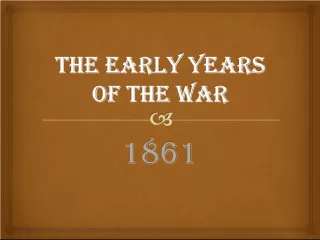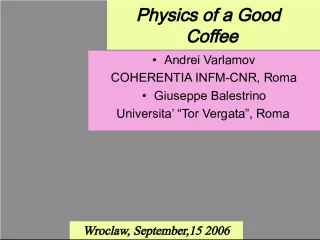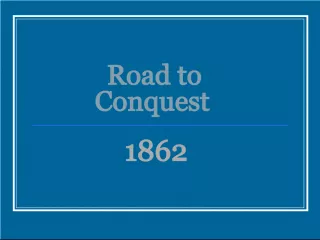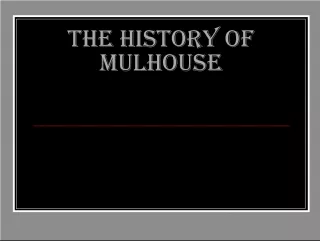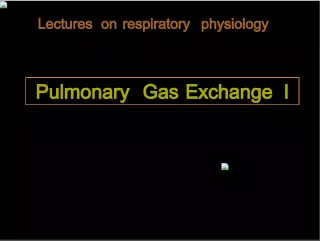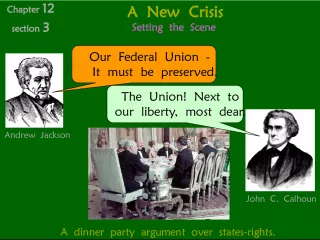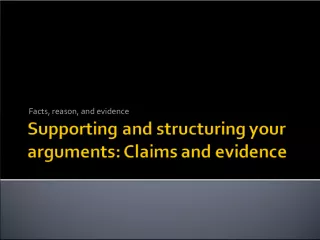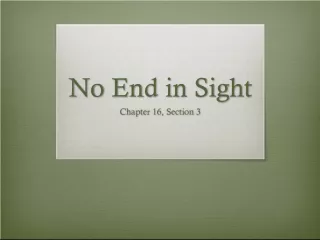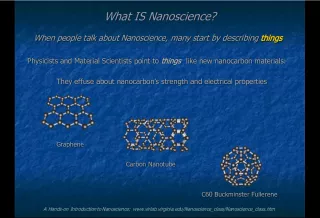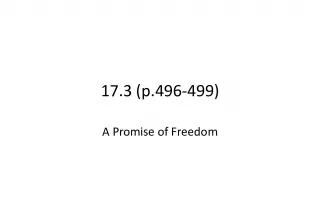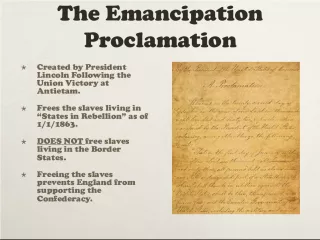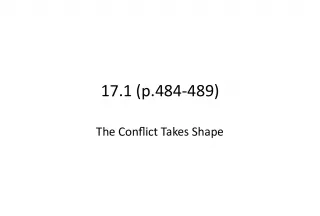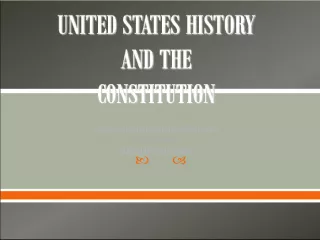"Introduction to A More Perfect Union"
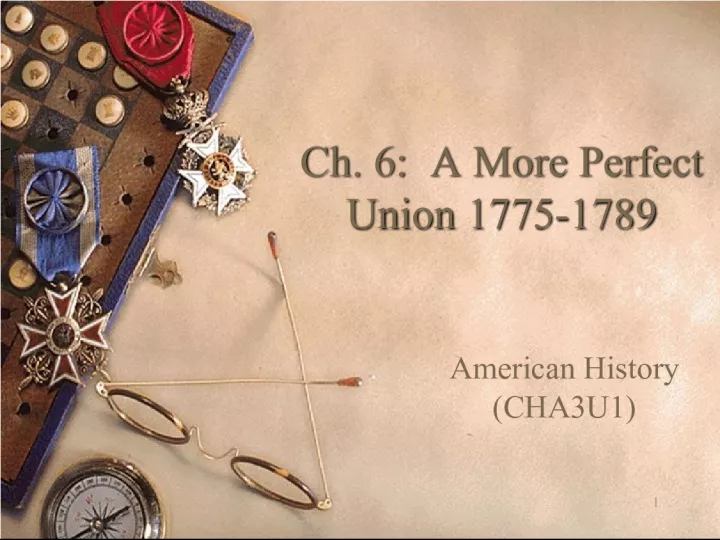

Get introduced to the American History series, "A More Perfect Union." Explore the foundations, events, and people that shaped the United States into the world power it is today.
- Uploaded on | 3 Views
-
 danielkinnunen
danielkinnunen
About "Introduction to A More Perfect Union"
PowerPoint presentation about '"Introduction to A More Perfect Union"'. This presentation describes the topic on Get introduced to the American History series, "A More Perfect Union." Explore the foundations, events, and people that shaped the United States into the world power it is today.. The key topics included in this slideshow are . Download this presentation absolutely free.
Presentation Transcript
1. 10/22/2014 1 Ch. 6: A More Perfect Union 1775-1789 Ch. 6: A More Perfect Union 1775-1789 American History (CHA3U1)
2. 10/22/2014 2 Introduction state and national govts are established under the Articles of Confederation, but new national govt weak many Americans fear strong executive power Strong central authority needed to keep the republic intact Constitution created
3. 10/22/2014 3 Constitution Signing
4. 10/22/2014 4 Sec. 1: Govt in Transition New state govts bicameral (two house legislatures) similar to colonial govt Distrust of strong executive power made state governors weak with only 1 yr terms and no veto powers Citizenship Restrictions only white male property owners could vote George Washington
5. 10/22/2014 5 Sec. 1: Govt in Transition Religious Freedom Southern colonies disestablished Church Of England but New England still gave tax support to Congregational Church States still discriminated based on gender, race, religion & economic standing, but trial by jury & freedom of the press existed
6. 10/22/2014 6 The Articles of Confederation 1777 Congress completed A of C the first attempt at a central government 1781 A of C ratified after 4 yrs of dispute over western land claims by Virginia when British General Cornwalliss army moved towards Virginia
7. The Albany Plan The States were wary of a strong central government so they took Benjamin Franklins Albany Plan as their guide They created what they called a firm league of friendship among the states Originally Congress was a unicameral system (one house) and each state had one vote (this would later cause a problem due to population differences 10/22/2014 7
8. Problems with the Plan The national government proved ineffective for a number of reasons 1. No executive branch to carry out laws 2. No federal courts to interpret laws 3. Congress did not have the power to tax or or regulate commerce 4. Congress had to depend on the generosity of the states for income but they didnt give enough Because the central government had no real power no one really attended session (it was difficult to even convene to ratify the treaty ending the Revolutionary war in 1783 10/22/2014 8
9. 10/22/2014 9 Foreign Relations Treaty Violations British and Americans did not carry out the terms of the Treaty of Paris 1783 with the British not abandoning their northern forts The Americans treated Loyalists harshly and courts heavily favoured the American side in grievance cases regarding Britain American Trade Suffers American ships were banned from the West Indies and only allowed into English ports with the products of their home states
10. 10/22/2014 10 Foreign Relations Trouble with Spain Spanish unhappy with the Treaty of Paris 1783 that gave the Americans all the land to the Mississippi R Spain controlled New Orleans & refused to follow the Treaty of Paris boundary inciting Natives to attack American settlers in the disputed areas
11. 10/22/2014 11 Foreign Relations Strained Relations with France French govt disappointed that there wasnt more trade with America after the high cost of helping America against the British Barbary Pirates unprotected by the British, North African states captured American ships that didnt pay a tribute
12. 10/22/2014 12 Settling the West The West was the next area of settlement Late 1700s area of settlement just west of the Appalachian Mts Congress (National Govt) could not meet the needs of settlers (protection from Natives, Spanish control of Miss. R.)
13. 10/22/2014 13 Talk of Secession G. Washington made trip to Tennessee & Kentucky and observed that the region was barely hanging on to Confederation The areas were unable to obtain statehood from Congress so they were considering seceding from the Union As a result two laws were established that set a precedent for the future growth of the nation
14. 10/22/2014 14 Land Ordinance of 1785 more orderly method for settling public land north of the Ohio River Land would be surveyed and divided into townships six miles square Land would be sold for $1 per acre in 640 acre packages which could then be sold for a profit The Northwest Ordinance of 1787 region bounded by the Ohio R., Great Lakes, Miss. R. divided into 3 territories whenever 5000 adult male citizens settled in a territory they could set up a territorial govt like a British colony The national government would appoint and pay judges and a territorial governor Same rights as original 13 colonies freedom of religion, speech, and assembly Prohibited slavery north Territory 60,000 people statehood
15. 10/22/2014 15 State Disputes The eastern states engaged in disputes with one another as a result of suspicion and rivalry from the postwar depression that occurred following the Revolution Boundary and Tax Disputes Vermont claimed by New York, New Hampshire, Massachussetts Pennsylvania & Connecticut almost went to war States taxed each others products Each state had their own currency
16. 10/22/2014 16 Shays Rebellion Daniel Shay led a farmers rebellion in Mass against the state government because farmers were losing their farms to debt Rebellion caused great alarm among those who believed in orderly government Showed need for strong central government
17. 10/22/2014 17 Toward a New Constitution A meeting was called in the states of Philadelphia, for the sole and express purpose of revising the Articles of Confederation. The Philadelphia Convention was set for May 24, 1787 12 of the 13 states were represented (Rhode Island was not present) 55 delegates attended the convention many of the most able political leaders (e.g. Washington, Franklin, Madison) Their goal was to work out a plan for a stronger central government
18. 10/22/2014 18 The Virginia Plan James Madison from Virginia was the first delegate to arrive with a draft of a new framework of government The document became the basis for discussion in the convention Constitution of the United States would be based on Madisons Virginia Plan
19. 10/22/2014 19 Conflicting Plans Almost all the delegates agreed that the Articles were hopelessly weak but there were two large stumbling blocks 1. Representation dispute between large and small states 2. Northern and Southern States disagreed over economics issues and slavery
20. Representation The small states wanted the same number of votes as the larger states in Congress but the larger states felt it wasnt fair Large states favoured a national government with separate executive, legislative and judicial branches The Great Compromise the lower house of Congress would see representation based on population & in the upper house of Congress everyone would have one vote 10/22/2014 20
21. Economic Issues & Slavery Dispute arose between the commercial North and the plantation interests of the South Southerners wanted to count slaves to determine representation to Congress but not for direct taxation The North wanted to count slaves for taxation but not for representation three-fifths compromise established that five slaves would be equal to three free persons for the purposes of representation and taxation 10/22/2014 21
22. The Issue of Slavery South Carolina and Georgia were afraid that the national government might act against slavery They insisted that the Constitution forbid interference with the slave trade The delegates agreed that for 20 years the national government would not prevent the importation of slaves 10/22/2014 22
23. The New Government The new government had more power It could levy and collect taxes the taxes had to be uniform throughout the states It could regulate commerce with foreign nations and between the states It could write and enforce commercial treaties that would increase foreign trade It could keep the trade states free of barriers It could coin money and regulate its value states would no longer make their own money 10/22/2014 23
24. 10/22/2014 24 Ratification Struggle September 17, 1787 39 of the original 55 delegates signed new Constitution 11 of the 13 states would ratify the Constitution (July 1788) they needed 9 states to ratify Votes were close as many Anti-Federalists opposed the Constitution fearing it gave too much power to the Federal government
25. Federalism Strong central government States would not print their own money but use the national currency The Principle of shared power is called FEDERALISM States deal with their own issues but work together with the federal government 10/22/2014 25
26. Levels of Government Executive Branch President of the United States Legislative Branch Congress Bicameral (two houses) Judicial Branch Supreme Courts evaluates validity of laws 10/22/2014 26
